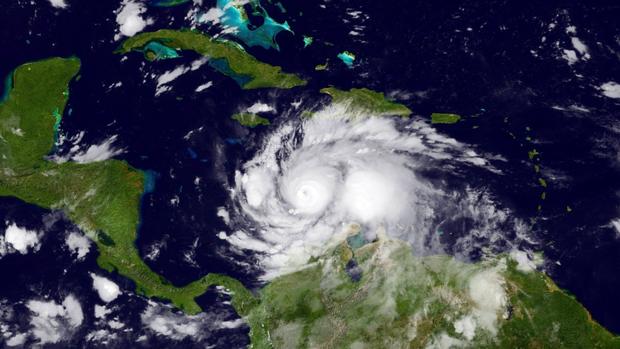Hurricane Matthew, a massive Category 4 storm, turns northwest in Caribbean
KINGSTON, Jamaica -- Hurricane Matthew, a potentially devastating Category 4 storm, finally took its long anticipated turn to the north as it nears Haiti and Jamaica.
It’s northward turn has prompted some officials on the U.S. East Coast to start making preparations.
The storm swirled across the Caribbean Sunday toward Haiti and Jamaica, where residents frantically stocked up on emergency supplies and authorities urged people to evacuate threatened areas.
South Carolina’s emergency preparedness officials have begun preparing for Hurricane Matthew.
The U.S. State Department warned American citizens to leave both Haiti and the Bahamas in advance of the storm.
In a news release issued Sunday, the South Carolina Emergency Management Division recommended that the state’s emergency response team review plans. Officials Horry, Beaufort and Charleston counties say they’re on alert status.
Division Director Kim Stenson held conference calls this weekend with county emergency managers, emergency response team agencies and local National Weather Service offices. Stenson says the storm’s path is too uncertain to rule out any possibility.
Matthew is one of the most powerful Atlantic hurricanes in recent history and briefly reached the top classification, Category 5, becoming the strongest hurricane here since Felix in 2007.
The eye of the approaching Category 4 hurricane, with maximum sustained winds of 130 mph early Monday, was expected to pass to the east of Jamaica and then cross over or be very close to the southwestern tip of Haiti late Monday or early Tuesday, the U.S. National Hurricane Center in Miami said. It was predicted to hit the lightly populated eastern tip of Cuba on Tuesday afternoon.
Forecasters said as much as 40 inches of rain could fall on some isolated areas of Haiti, raising fears of deadly mudslides and floods in the heavily deforested country where many families live in flimsy houses with corrugated metal roofs.
After passing Jamaica and Haiti, Matthew is expected to reach Cuba late Monday, potentially making a direct hit on the U.S. Navy base at Guantanamo Bay, where authorities said they were evacuating non-essential personnel, including about 700 family members of those serving there.
Everyone remaining behind was being told to take shelter, said Julie Ann Ripley, a spokeswoman. There are about 5,500 people living on the base, including 61 men held at the detention center.
The government of Haiti opened 1,300 emergency shelters across the country, enough to hold up to 340,000 people. Authorities broadcast warnings over the radio and across social media, trying to counter a common tendency for people to try to stay in their homes to protect them during natural disasters.
“The shelters are open but I don’t believe we have anyone inside them just yet,” said Joseph Edgard Celestin, a spokesman for the civil protection agency.
Forecasters said the slow-moving Matthew was expected to dump 15 to 25 inches of rain over southern Haiti, with a few places getting as much as 40 inches.
The forecast track would also carry Matthew into the Bahamas, with an outside chance of a brush with Florida, though that would be several days away.
“It’s too early to rule out what impacts, if any, would occur in the United States and Florida,” said Dennis Feltgen, a spokesman at the Hurricane Center.
In Haiti, civil protection officials broadcast warnings of a coming storm surge and big waves, saying the country would be “highly threatened” from the approaching system, and they urged people to prepare emergency food and water kits.
Emergency management authorities banned boating, particularly along the southern coastline.
In Jamaica, flooding temporarily closed the road linking the capital to its airport. Carl Ferguson, head of the marine police, said people were starting to heed calls to relocate from small islands and areas near rural waterways.
In the coastal town of Port Royal, officials urged residents to seek refuge in government shelters and people in the capital, Kingston, crowded supermarkets to buy bottled water, canned food, flashlights and batteries.
“It has been chaos from the morning,” said Melain Azan, owner of the Azan Super Centre.
Shopper Nardia Powell said she was stocking up because she learned a hard lesson when she was unprepared for Hurricane Ivan in 2004, as were many others. “So, I just want to be on the safe side, right?” she said.
As of 11 p.m. EDT, the storm was centered about 325 miles southwest of Haiti’s capital of Port-au-Prince. It was moving north at 5 mph.
Earlier, two deaths were blamed on the storm as it pushed through the eastern Caribbean and skimmed past the northern tip of South America.
Damage appeared minimal despite flooding in towns along Colombia’s La Guajira peninsula. Some officials were even grateful for the rain after a multi-year drought.
“Families that evacuated are returning to their homes,” said La Guajira Gov. Jorge Velez. “The dikes and wells filled up, the earth is moist, and this benefits agriculture in an area where it hasn’t rained for five years, benefiting the community.”

